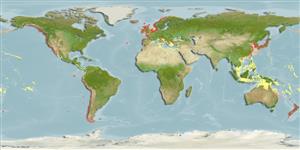Common names from other countries
Environment: milieu / climate zone / depth range / distribution range
Ekologi
. Subtropical
Western Pacific.
Length at first maturity / Size / Weight / umur
Maturity: Lm ? range ? - ? cm Max length : 3.0 cm H jantan/; (Ref. )
Relatively small with tentacular crown up to 3.5 centimeters in diameter and 3 cm in height. Smooth green-gray or brown cylindrical column that may or may not have vertical orange or white stripes. 50 to 100 slender, tapering tentacles that are fully retractile, usually transparent, sometimes gray or light green flecked with white.
Known from infralittoral zones (Ref. 85338). Solitary (Ref. 2377). Found on rock surfaces, attached to one spot but can glide over the substrate. Will feed on any animal it can catch and swallow (Ref. 125338).
Life cycle and mating behavior
Kematangan | Reproduksi, perkembang biakan | Pemijahan | telur-telur | Fecundity | Larva
Capable of both asexual reproduction, through longitudinal fission, and sexual reproduction through release of gametes by both sexes followed by external fertilization and embryonic development (Ref. 3248).
rujukan utama
Acuan | Koordinator | mitra
Cairns, S.D., D.R. Calder, A. Brinckmann-Voss, C.B. Castro, D.G. Fautin, P.R. Pugh, C.E. Mills, W.C. Jaap, M.N. Arai, S.H.D. Haddock and D.M. Opresko. 2003. (Ref. 1663)
Status IUCN Red List (Ref. 130435)
status CITES (Ref. 108899)
Not Evaluated
Not Evaluated
ancaman kepada manusia
Harmless
penggunaan manusia
| FishSource |
Alat, peralatan
informasi lanjut
Umur / SaizPertumbuhanpanjang-beratpanjang-panjangMorfologiLarvaKelimpahan
Sumber internet
Estimates based on models
Preferred temperature
(Ref.
115969): 8 - 21.9, mean 12.1 (based on 886 cells).
keancaman
Low vulnerability (10 of 100).
kategori harga
Unknown.
